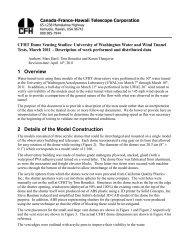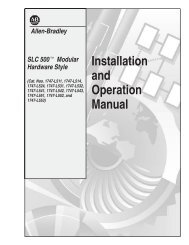Booklet ready version - Canada France Hawaii Telescope ...
Booklet ready version - Canada France Hawaii Telescope ...
Booklet ready version - Canada France Hawaii Telescope ...
You also want an ePaper? Increase the reach of your titles
YUMPU automatically turns print PDFs into web optimized ePapers that Google loves.
signatures of the chemical and dynamical origins of stellar populations present in the observed positions,<br />
velocities and colors of stars - in the closest giant galaxy to us, Andromeda.<br />
Andromeda is, in many ways, an ideal target that neatly compliments similar studies of our own Galaxy.<br />
Whereas the precision and detail of observations that can be obtained for the Milky Way will always surpass<br />
those possible for extra-galactic targets, a clear panoramic view is unattainable due to our awkward viewing<br />
angle, extinction, crowding, and the vast area that must be surveyed. No such problems exist for Andromeda,<br />
and individual stars can still be resolved and analyzed, albeit at a lower signal-to-noise.<br />
PAndAS has observed nearly 400 square degrees of sky in the vicinity of the Andromeda Galaxy, and its nearby<br />
neighbor, the Triangulum Galaxy (separated by 15 degrees in projection, or about 225kpc). Observations are<br />
conducted in the g and i filters, for a total of 1450 seconds in each. The resulting observations are generally<br />
sufficient to reach S/N=10 for point sources at g=25.5 and i=24.5. Relative to M31, they resolve stars in the top<br />
several magnitudes of the red giant branch. Indeed, as of the end of S09B, more than 30 million stellar sources<br />
are resolved in PAndAS data.<br />
Figure 1<br />
A tangent plane projection<br />
of the spatial<br />
density distribution of<br />
red giant branch stars<br />
across the PAndAS<br />
area (as of the end of<br />
S09B) a convenient<br />
proxy for the light distribution<br />
when dealing<br />
with very faint structures.<br />
The outermost<br />
circle corresponds to a<br />
projected radius from<br />
M31 of 150kpc. Small<br />
circles highlight dwarf<br />
galaxy companions to<br />
M31 and M33. Red<br />
circles highlight new<br />
dwarfs discovered<br />
within the past year<br />
(Richardson et al.<br />
2011, ApJ, in press).<br />
Figure 2<br />
Projection of the orbit<br />
of M33 and M31 that<br />
best reproduces the<br />
extended structure<br />
surrounding the disk<br />
of M33 first observed<br />
in the PAndAS dataset,<br />
showing the relative<br />
position of the<br />
galaxies as a function<br />
of time in their orbit.<br />
The right panel shows<br />
the simulated stellar<br />
surface brightness<br />
distribution of the<br />
M33 disk at the present<br />
day, which closely<br />
matches the observations<br />
(McConnachie<br />
et al. 2009, Nature,<br />
461, 66).<br />
Unearthing fossils of formation<br />
Figure 1 shows the spatial density distribution<br />
of red giant branch stars<br />
across the PAndAS area, a convenient<br />
proxy for the light distribution when<br />
dealing with very faint structures. The<br />
sheer scale of this image - and the fact<br />
that it isn’t empty! - is surprising. The<br />
main disk of M31 is included for scale,<br />
and the presence of structures at all<br />
more than 10 degrees from the center<br />
of M31 is a startling visual confirmation<br />
of the vast (and generally unappreciated)<br />
scale of galaxies.<br />
And what of the structures themselves?<br />
A plethora of extended streams, loops,<br />
clumps and blobs cover the entire map,<br />
extending out to projected radii in excess<br />
of 130kpc (>20 scale lengths).<br />
Many individual structures, such as the<br />
large loop in the north-west, are greater<br />
than 100kpc in extent. And perhaps<br />
most striking of all is the number of highlighted, concentrated, stellar over-densities: these are dwarf galaxy<br />
satellites of M31/M33, the vast majority of which were unknown prior to these observations: so far, 19 new<br />
dwarf galaxies have been uncovered by PAndAS, with more likely to be discovered.<br />
One of the most<br />
unexpected early<br />
results from PAndAS<br />
involved the<br />
faint, extended,<br />
structure surrounding<br />
the disk<br />
of M33. Analysis<br />
suggests that it is<br />
a result of a previous<br />
interaction<br />
with M31 as M33<br />
orbits around its<br />
more massive<br />
companion. This<br />
finding fits with<br />
several other pieces<br />
of circumstan-<br />
18 2009 & 2010<br />
Queued Service Observing at CFHT: Two<br />
years of transition<br />
The main goal of the Observatory Automation Project was to bring modifications and improvements to CFHT's<br />
systems so that only one person could operate the telescope and instrument remotely from CFHT's headquarters<br />
in Waimea.<br />
Since its first light in 1979, CFHT has been operating under the Classical observing mode. This mode is still<br />
used a few nights per year. In Classical observing mode from the summit of Maunakea, two people are required<br />
to be present together for safety reasons. A <strong>Telescope</strong> Operator and one or more visiting astronomers perform<br />
the observations.<br />
A little over 10 years ago, on January 29, 2001, CFHT reached a milestone with its first Queued Service<br />
Observations. Under this observing mode, the Observing Assistant (OA) performs the duties of a telescope<br />
operator while the Service Observer (SO), essentially takes the role of the visiting astronomer.<br />
The SOs are hired and trained by CFHT to operate instruments, determine which observation to carry out based<br />
on priorities and sky conditions, and perform the data acquisition and preliminary quality assessment. By 2008,<br />
CFHT had its three main instruments operated under the QSO mode. CFHT will perform its first remote queued<br />
service observations in early 2011, with no personnel at the summit and only one Remote Observer (RO)<br />
performing all the necessary duties from the CFHT headquarters in Waimea.<br />
In order to ensure an efficient and smooth transition from a 2-person on-site operation to a single-person remote<br />
operation, a training program was carefully designed. After defining the goals of the training, OAs and SOs<br />
completed modules covering every aspect of telescope control, dome and windscreen operation, weather<br />
monitoring, instrument functionality and operation, evaluation of scientific programs, astronomical techniques,<br />
principles of QSO as used at CFHT, data quality evaluation, etc. After two years, four candidates were hired as<br />
CFHT's Remote Observers.<br />
At the summit<br />
In the observing<br />
room, the left desk (2-<br />
and 4-screen panels)<br />
are for the SO, and<br />
the right desk is for<br />
the OA, operating the<br />
telescope. The environment<br />
has been<br />
modified to handle<br />
remote operations:<br />
hands on mice or<br />
keyboards only !<br />
In Waimea<br />
The remote observing<br />
room is <strong>ready</strong>!<br />
The environment is<br />
very similar to the<br />
summit setup. The<br />
2-screen and 4-<br />
screen panels on the<br />
left take care of the<br />
control of the summit<br />
facility and of the instrument,<br />
while the<br />
next two screens on<br />
the desk are used for<br />
the control of the telescope.<br />
CFHT Annual Report 23




![Documentation [PDF] - Canada France Hawaii Telescope ...](https://img.yumpu.com/26965302/1/190x245/documentation-pdf-canada-france-hawaii-telescope-.jpg?quality=85)







